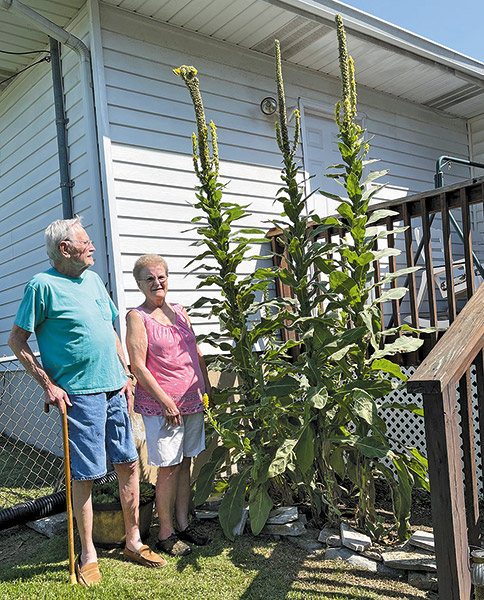Is it a flower, or is it a weed?
Clinton couple’s mullein plants are now in bloom

Bobby and Rosemary Sharp of Highland Drive in Clinton look over the elusive mullein plants that popped up in their yard this year in this spot near their back porch. The plants are known for their medicinal purposes, and have small yellow flowers at the tops of the stalks when they are in bloom. (photo:G. Chambers Williams III )
The Sharps say the mullein plants in their yard seem to pop up magically every year about this time.
Last week, the mullein plants near their back porch were showing pretty much full bloom of their small yellow flowers, which sit at the top of gangly looking green stalks that stand about 10 feet tall.
“They don’t come up in the same spot every year,” said Rosemary Sharp. “They are always in a different spot.”
The Sharps have been seeing the mullein plants in their yard the whole eight years they’ve lived there.
And those stalks seem to shoot up almost overnight, even though the large, green flat leaves at the base of the plant are seen shortly after spring arrives each year, she said.
“About six weeks ago the stalks started coming up,” Mrs. Sharp said.
“I remember seeing mullein in the cow pastures when I was a kid growing up in New River,” she said. “But I never saw them flower back then.”
The mullein plant is considered a nice addition to a flower garden by some people, or an invasive weed by others.
But they are considered by some folks to have medicinal value, the Sharps said.
“Old folks boiled the plants in pots to help people with things like whooping cough,” Bobby Sharp said.
Indeed, articles on gardening websites talk about the different medicinal uses for mulleins.
“When it is grown as an herbal remedy, every part of the mullein plant is usable at different times during its life cycle,” said Ed Powers, Jefferson County, Colorado, master gardener, in an article on the website morningagclips.com.
“The thick, soft leaves are made into a tea to treat respiratory problems by loosening congestion and helping clear the lungs,” he said. “The tiny hairs on the leaves can be irritating, and any teas should be filtered carefully to avoid this problem. A tincture (or an extract) of mullein alleviates this problem.
“In addition, mullein flowers can provide a soothing and cleansing effect on the skin,” Powers noted. “Use mullein as a wash or balm for minor skin wounds or disorders by infusing flowers in olive oil and adding beeswax to make a balm. When looking for wild mullein, only harvest from straight, vigorous stalks that have not been treated with herbicide.”
From the GardeningKnowHow.com website, writer Becca Badgett says of mullein:
“You’ve likely seen mullein … growing in fields and along roadsides. They’re often attractive, with tall spikes of yellow flowering rosettes. This biennial plant, Verbascum thapsus, was historically used as an herbal treatment for coughs, congestion, chest colds, bronchitis, and inflammation.
“Native Americans and soldiers during the Civil War era made teas from leaves of mullein plants to treat asthma,” she said. “During the 1800s, settlers used it in their compounds to treat tuberculosis.”
Bobby Sharp said visitors to their home find the mullein plants unusual and interesting.
“People say they have never seen anything like this,” he said.
There are some mullein plants in view right now on a hillside along Interstate 75 just north of Exit 122, but those are not nearly as tall as the ones in the Sharps’ back yard.
“They will be back next year,” Rosemary Sharp said of the mullein in her yard. “We just don’t know where.”
